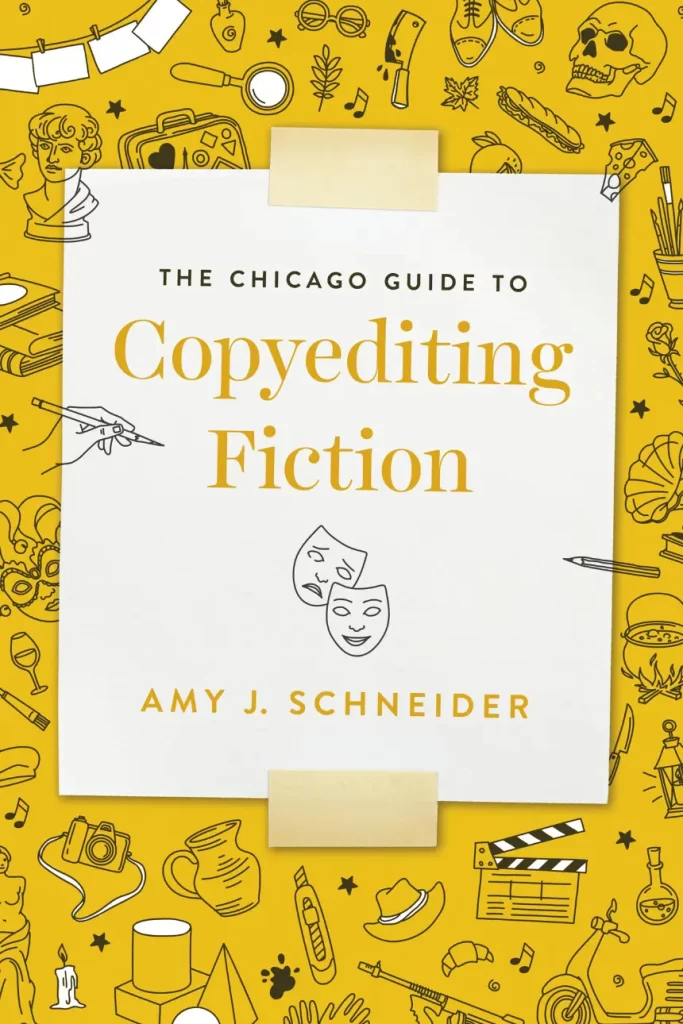A quality and detailed manual to help in technically revising and formatting works of fiction.
Writers and editors, certainly ones new to the trade, are inclined to focus on the importance of official style when it comes to nonfiction writing. The more “serious” the topic, the more important—surely—that the formatting matches the tone. As a result, most writing guides tend to exclude or downplay the value of stylizing fiction in a similar way. Even The Chicago Manual of Style, the Good Book for copyeditors and publishers, primarily focuses on academic writing with its details and instructions.

Experienced copyeditor Amy J. Schneider, thankfully, has given copyeditors and writers alike a gift in the form of The Chicago Guide to Copyediting Fiction. Perhaps the first book to cater toward fiction copyediting, and there could be no better one.
This short and thorough book can be useful for new authors as well as copyeditors. Those hoping to get their foot in the door and be taken seriously will have a better chance of doing so if their writing submissions already look formatted and include quality prose and narrative.
The minutiae and specification of details—how to write numbers, dates, and punctuation—are as easily forgotten for fiction readers as authors yet are no less important than they are for journalists and academics. Schneider provides an easy tip to remember in writing numbers in dialogue (how would a character say a number?); usually, dates are digits for narration and spelled out in dialogue; when so much of punctuation is a creative choice, it is important for copyeditors to understand their authors to ensure consistency with diction and flow within a work, and to watch for issues such as the serial/spousal comma, phrasal adjectives, and ellipses.
Grammar is far more informal in fiction than in nonfiction, and the rules can be fast and loose for every fiction copyeditor’s style sheet. In dialogue, characters usually won’t remember “who” versus “whom,” and most authors prefer not to use semicolons there out of a sense of formality. Sentence fragments are okay, especially for capturing urgency in tone and pacing, and characters speak in informal fragments just like real people do. The narrator’s point of view needs to be constant: past tense is usually the easiest tense to edit, be it in first or third person, and the tendency to avoid slipping into that mindset is important when editing present-tense narration.
One of the simplest parts of copyediting that authors often don’t notice amid prose and plot, despite its need, is consistency. When trying to keep track of their own book, certainly when self-editing, authors need to have a certain degree of organization, and when things slip through the cracks of the story itself, the copyeditor steps in.
“Every fiction style sheet should include a character list…a tidy alphabetical list of character names.” Details mentioned in passing can be forgotten or overlooked easily, and style sheets are there to fill in the blanks: dietary preferences, relationships, physical description, background; even animals and significant objects have a place here. Main characters to minor characters all have a place; readers are sharp-eyed, and writers and copyeditors need to be at the ready.
Locations are another major component, primarily when an author draws from real life to create settings. An American writer may write about characters in China, but they could totally misestimate the distance between Hong Kong and the Great Wall, as one example, and many writers barely scratch the surface in understanding details such as weather, buildings, road maps, and more in recreating reality. Timelines are also significant in measuring the traveling distance, and the story’s timeline should be placed against locations’ history for alignment.
The greatest responsibilities of editing dialogue belong to authors, as some publishers have guidelines that copyeditors are only allowed to query authors rather than outright edit dialogue. People as a rule don’t speak in perfect grammar constantly, and so trying to “correctly” edit heat-of-the-moment conversation would lead to a lack of realism. The main things to keep in mind when editing dialogue are:
- A sense of voice for characters, with factors such as accents and education level, as befits their background.
- Every day, incomplete sentences, interruptions, muddled syntax, and slang.
- The proper usage of dialogue tags alongside action beats and verbs of utterance.
- Ensuring the right amount of dialogue tags and action beats in a longer exchange.
- Punctuation: the correct dashes and ellipses to indicate pauses and trailing off, where to add emphasis.
- Correctly handling e-dialogue and how to translate non-English dialogue.
Fiction copyeditors are not supposed to be authors, critics, or grammar masters, and this book helps remind them of their actual job: mechanics. This is not a truly creative job, even with fiction as the copyediting task, but it can be a fun one. The copyeditor also gets the chance to enjoy the work while participating in its existence, learning and engaging to make a potentially great narrative a more perfect story. When an author seeks to be their copyeditor, even in initial drafts rather than a more polished version, they can understand their creation in an entirely new way and further its quality. There’s no better way to learn these essential tips and tricks than through Schneider’s The Chicago Guide to Copyediting Fiction, and there is no better companion to have when traveling the multiple paths that fiction can lead writers and editors down.
By Grace Dietz
Grace is an Editorial Assistant at Technica Editorial



